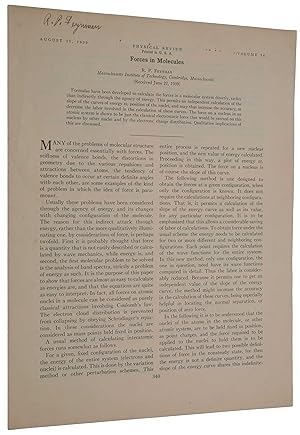Feynman, First Edition, Signed (19 results)
FeedbackSearch filters
Product Type
- All Product Types
- Books (16)
- Magazines & Periodicals (No further results match this refinement)
- Comics (No further results match this refinement)
- Sheet Music (No further results match this refinement)
- Art, Prints & Posters (No further results match this refinement)
- Photographs (No further results match this refinement)
- Maps (No further results match this refinement)
- Manuscripts & Paper Collectibles (3)
Condition Learn more
- New (No further results match this refinement)
- As New, Fine or Near Fine (3)
- Very Good or Good (3)
- Fair or Poor (No further results match this refinement)
- As Described (13)
Binding
Collectible Attributes
Language (2)
Price
- Any Price
- Under £ 20 (No further results match this refinement)
- £ 20 to £ 35 (No further results match this refinement)
- Over £ 35
Free Shipping
Seller Location
Seller Rating
-
Perfectly Reasonable Deviations from the Beaten Track / The Letters of Richard P. Feynman (SIGNED BY THE EDITOR, MICHELLE FEYNMAN)
Published by Basic Books / A Member of the Perseus Books Group, New York, 2005
ISBN 10: 0738206369 ISBN 13: 9780738206363
Language: English
Seller: Cat's Curiosities, Pahrump, NV, U.S.A.
First Edition Signed
Hardcover. Condition: Very Good. Dust Jacket Condition: Near Fine. 1st Edition. Number line complete 10 9 8 7 6 5 4 3 2 1 -- the posthumous first printing. Signed in blue felt-tip to bottom of the title page by the editor Michelle Feynman (though the editor's signature consists primarily of her initials). 486 pp. including Index. Reduced from $127. Inscribed by Author(s).
-
TUVA OR BUST!: Richard Feynman's Last Journey
Published by W.W. Norton & Company, New York, 1991
ISBN 10: 0393029530 ISBN 13: 9780393029536
Language: English
First Edition Signed
Condition: Fine in near fine jacket. First printing. Inscribed first edition of this personal account of the deepening friendship between the author and the Nobel Prize-winning physicist over their shared "decade-long quest" to visit the tiny republic of Tannu Tuva. 8.25'' x 5.5''. Original half red cloth over beige paper boards, gilt-lettered spine. In original color photographic jacket ($19.95). Illustrated in black and white. Vinyl sample mounted to front fly leaf. 256 pages. Inscribed by Leighton in blue on half-title: "To Fernando Vega / with best wishes / May the memory of Richard Feynman / live forever! / Ralph Leighton / Sept. 1, 1995/ Los Angeles." Jacket with touch of edgewear. Book fresh.
-
Elementary Particles and the Laws of Physics: The 1986 Dirac Memorial Lectures
Published by Cambridge University Press, New York , New York, 1987
ISBN 10: 0521340004 ISBN 13: 9780521340007
Language: English
Seller: Dallas Surplus Stacks, Dallas, TX, U.S.A.
First Edition Signed
Hardcover. Condition: Fine. Dust Jacket Condition: Fine. 1st Edition. Fine Book & Jacket, First Edition First Print, Signed by Steven Weinberg to Title Page with Provenance to buyer, in a Protective cover, carefully packed & shipped in a box. Signed by Author(s).
More buying choices from other sellers on AbeBooks
Used offers from £ 330.97
Also find Hardcover First Edition Signed
-
Surely You're Joking, Mr. Feynman: Adventures Of A Curious Character ***Signed***
Published by W. W. Norton & Company, New York, NY, 1985
ISBN 10: 0393019217 ISBN 13: 9780393019216
Language: English
Seller: Legends In History, Meadow Vista, CA, U.S.A.
First Edition Signed
Hardcover. Condition: Near Fine. Dust Jacket Condition: Near Fine. 1st Edition. Inscribed "To Don Roth / Richard Feynman" on title page in black ink. This is a First Edition / Eight Printing in Near Fine book and dust jacket. JAMES SPENCE Authentication JSA Letter Of Authenticity Richard Phillips Feynman; May 11, 1918 - February 15, 1988) was an American theoretical physicist, known for his work in the path integral formulation of quantum mechanics, the theory of quantum electrodynamics, and the physics of the superfluidity of supercooled liquid helium, as well as in particle physics for which he proposed the parton model. For his contributions to the development of quantum electrodynamics, Feynman, jointly with Julian Schwinger and Shin'ichir? Tomonaga, received the Nobel Prize in Physics in 1965. Feynman developed a widely used pictorial representation scheme for the mathematical expressions describing the behavior of subatomic particles, which later became known as Feynman diagrams. During his lifetime, Feynman became one of the best-known scientists in the world. In a 1999 poll of 130 leading physicists worldwide by the British journal Physics World he was ranked as one of the ten greatest physicists of all time. He assisted in the development of the atomic bomb during World War II and became known to a wide public in the 1980s as a member of the Rogers Commission, the panel that investigated the Space Shuttle Challenger disaster. Along with his work in theoretical physics, Feynman has been credited with pioneering the field of quantum computing and introducing the concept of nanotechnology. He held the Richard C. Tolman professorship in theoretical physics at the California Institute of Technology. Feynman was a keen popularizer of physics through both books and lectures including a 1959 talk on top-down nanotechnology called There's Plenty of Room at the Bottom and the three-volume publication of his undergraduate lectures, The Feynman Lectures on Physics. Feynman also became known through his semi-autobiographical books Surely You're Joking, Mr. Feynman! and What Do You Care What Other People Think? JAMES SPENCE Authentication JSA Letter Of Authenticity. Signed by Illustrator(s).
-
Les Prix Nobel En 1965: The Development of the Space-Time View of Quantum Elektrodynamics Nobel Lecture
Published by The Nobel Foundation, Stockholm, 1966
Seller: Manhattan Rare Book Company, ABAA, ILAB, New York, NY, U.S.A.
Manuscript / Paper Collectible First Edition Signed
Original Wrappers. First Edition. EXTREMELY RARE SIGNED FIRST EDITION OFFPRINT OF FEYNMAN'S NOBEL PRIZE LECTURE. Feynman fancied himself a man who could see through the fluff. When asked by the BBC whether his findings deserved a Nobel Prize, Feynman classically responded: "I've already got the prize. The prize is the pleasure of finding the thing out, I don't believe in honors." This attitudewhat Feynman himself coined, "a disrespect for the respectable,"was a product of his upbringing. As a young boy, Feynman's father, a uniform salesman, would often attempt to teach the young Feynman a lesson, opening a photo in the New York Times and showing Feynman an image of the Pope or a politician, surrounded by bowing admirers. He would then ask Feynman what made the Pope different from the 'ordinary' people around him. The answer, his father explained, was in the man's uniform, his title, and his prizes. [Sykes, "The Pleasure of Finding Things Out"]. This early 'disrespect for the respectable' was intertwined with Feynman's approach to knowledge. He detested false certainty: those who used big words without knowing their meanings, or theorized without understanding basic principles. This attitude is reflected in his scientific approach. Colleagues recalled how, when they presented theories to him, Feynman would make them explain their ideas from the ground up. Starting with elementary questions, he would force them to build their arguments from the simplest foundations. Inevitably, at some point, a hole in the theory would appearrevealed by Feynman's method of thinking from bedrock knowledge [Sykes; Leighton]. Perhaps Feynman disliked awards because he understood them as working as an opposite process: creating differences not on bedrock, but on the basis of status conferred by, what he saw as, detached ceremonies in far off lands. It's also difficult to gauge if this attitude was wholly genuine. Feynman was a showman. Stories abound of Feynman's muted reaction to the Nobel. When awoken by a reporter at 3:00 AM, told of his award, and asked if he was pleased, Feynman responded, "I could have found out later in the morning." When, at a more reasonable hour, a reporter asked if there was a simple explanation of what he had discovered, Feynmanwho never lacked for wordsresponded that, "there certainly must be but I don't know what it is"[Douglas Smith]. For all of his public lack of concern in titles and distinction, by the time of his 1965 Nobel ceremony, Feynman seemed to have experienced a shift. In his acceptance speech, Feynman remained deeply critical of false knowledge. But he also expressed that honors "can generate good feeling, even love among men, even in lands far beyond [their] own." As Feynman identified it, after the joy of discovery, comes a more personal occurrence: "the prize, and a deluge of messages from friends, from relatives, from students, from former teachers, from scientific colleagues, from total strangers.The prize was a signal to permit them to express and me to learn about their feelings. Each joy, though transient still, repeated in so many places, amounts to a considerable sum of human happiness. And each note of affection, released thus one upon another, has permitted me to realize a depth of love for my friends and acquaintances, which I had never felt so poignantly before." As part of his Nobel acceptance, Feynman delivered a much-awaited lecture on his winning research, titled "The Development of the Space-Time View of Quantum Electrodynamics". Perhaps unsurprisingly, Feynman took a personal tone in this address, tracing his personal and intellectual relationship with Quantum Electrodynamics (QED). Feynman reflected that, as an undergraduate at MIT, he had been most inspired by reading German-Jewish Physicist Walter Heitler, and English Physicist and Mathematician Paul Dirac. What stood out most to him in Dirac's texts were not his calculations but Dirac's motions to the theory's incompleteness. This incompleteness, Feynman l.
-
Static and Dynamic Electricity.
Published by McGraw-Hill Book Company, Inc, New York, 1950
Seller: Raptis Rare Books, Palm Beach, FL, U.S.A.
First Edition Signed
Richard Feynman's copy of Smythe's central work on static and dynamic electricity. Octavo, original cloth, illustrated with mathematic equations and diagrams. Signed in ink by Feynman on the front free endpaper, "R.P. Feynman 6688 Cal Tech Physics," beneath the previous owner's inscription. Feynman acquired this copy from a fellow member of the Caltech physics department, D.A. Guinier, after having met William R. Smythe during his graduate study at Princeton. This copy was then apparently given to Feynman's younger sister and world-renowned astrophysicist, Joan Feynman, who studied the origin of auroras and solar wind particles. In very good condition. Accompanied by a page of notes and equations relating to Harmonics written in what appears to be Guinier's hand. Housed in a custom half morocco clamshell box made by the Harcourt Bindery Professor of physics at Caltech and creator of the ion-velocity spectrometer, William R. Smythe quite literally wrote the book on applied electromagnetism. 'Static and Dynamic Electricity' examines the fundamental principles of electromagnetic theory and illustrates them through practical application to real problems in physics.
-
The Feynman Lectures On Physics.
Published by Addison-Wesley Publishing Company 1975; 1964; 1965, Reading, Massachusetts/Palo Alto, 1975
Seller: Raptis Rare Books, Palm Beach, FL, U.S.A.
First Edition Signed
Richard Feynman's own office copy of his collected lectures on physics, with his ownership signatures. Quarto, 3 volumes, original red cloth. With Feynman's ownership signature and address to the front free endpaper of volume one, "R. P. Feynman. Calif Instit. of Technology Pasadena, Calif. 795-6811 Ext. 2688" and signature to the front free endpaper of Vol. II, "Office R P Feynman." Each volume is in very good condition. Housed in a custom half morocco clamshell box by the Harcourt Bindery. From the library of Richard P. Feynman. A unique example of one of the most important physics texts ever published. "The whole thing was basically an experiment," Richard Feynman said late in his career, looking back on the origins of his lectures. The experiment turned out to be hugely successful, spawning a book that has remained a definitive introduction to physics for decades. Ranging from the most basic principles of Newtonian physics through such formidable theories as general relativity and quantum mechanics, Feynman's lectures stand as a monument of clear exposition and deep insight. More than 1.5 million English-language copies have been sold; probably even more copies have been sold in a dozen foreign-language editions.¬A 2013 review in¬Nature¬described the book as having "simplicity, beauty, unity . presented with enthusiasm and insight.".
-
?Surely You're Joking, Mr. Feynman!? Adventures of a Curious Character.
Published by W.W. Norton & Company, New York, 1985
Seller: Raptis Rare Books, Palm Beach, FL, U.S.A.
First Edition Signed
First edition, early printing of this collection of reminiscences by the Nobel Prize-winning physicist and one of the greatest scientific minds of the twentieth century. Octavo, original half cloth. Association copy, lengthily inscribed by the author to his cousin on the half-title page, "To Frances Lewine Hi Franky - send me your book -- you ought to write one-¬ it's easy, all you have to do is¬ tell all those wonderful stories of yours to some friend with an open tape recorder.¬ Richard." The recipient, Frances Lewine was known as a champion for the rights of women journalists throughout the 1950's, 60's, and 70s and worked to fight discrimination. Growing up near Feynman and his sister in Far Rockaway, Lewine was assigned to the White House in 1956 as a reporter covering the activities of first ladies and Washington society. In 1965, the same year Feynman won the Nobel Prize for Physics, Lewine became the first full-time female White House correspondent. Just over a decade later, she joined the administration of President Jimmy Carter and became the Department of Transportation's deputy director of public affairs in 1977. After Carter left office, Lewine joined the Cable News Network as an assignment producer and field producer at the age of 60. As her professional career, her letter, and Feynman's inscription suggest, she had many colorful stories to tell. In an unpublished letter to Feynman dated October 23, 1965, Lewine wrote "I have spread the word all over Washington-- including the White House that I am a close relative of the Nobel Prize winner-- and I am basking in glittering reflected glory. .'three cheers for Richard Feynman----and his cousins and his sisters and his aunts.' . Aside from clucking like [I'd] won the prize myself, I have been busy at the White House with LBJ's gall bladder." (Courtesy family of Joan Feynman). Near fine in a near fine dust jacket. Jacket design by Mike McIver. Told to Ralph Leighton. Edited by Edward Hutchings. Signed examples of this book are rare; inscribed copies are rarer still; and association copies are rarest of all. Indeed Feynman‚s signature has become something of a ‚Feynman story‚ of its own. The legendary physicist, it seems, who understood so much, could never understand why people collect autographs. He asked one collector, ‚Could you please write and explain it to me?‚ To another he wrote, ‚I‚m sorry to have to inform you that I do not send autographs‚; and then he signed the letter, thereby sending an autograph. He even made a bet, once, on how many times he would have to sign his name in connection with a certain speaking engagement. He lost. Requests for Feynman‚s signature were referred routinely to his secretary, who returned instead a printed card saying firmly that ‚Professor Feynman has found it necessary to refuse all requests for autographs.‚ Housed in a custom half morocco clamshell box made by the Harcourt Bindery. Richard Feynman, winner of the Nobel Prize in physics, thrived on outrageous adventures. Here he recounts in his inimitable voice his experience trading ideas on atomic physics with Einstein and Bohr and ideas on gambling with Nick the Greek; cracking the uncrackable safes guarding the most deeply held nuclear secrets; accompanying a ballet on his bongo drums; painting a naked female toreador. In short, here is Feynman's life in all its eccentric‚a combustible mixture of high intelligence, unlimited curiosity, and raging chutzpah. ‚A storyteller in the tradition of Mark Twain. He proves once again that it is possible to laugh out loud and scratch your head at the same time‚ (New York Times Book Review).
-
QED: The Strange Theory of Light and Matter.
Published by Princeton University Press, Princeton, 1985
Seller: Raptis Rare Books, Palm Beach, FL, U.S.A.
First Edition Signed
First edition of this work by the Nobel Prize-winning physicist regarding quantum electrodynamics, which James Gleick calls it "a model of science writing." Octavo, original cloth. Association copy, inscribed by the author to his sister on the half-title page, "Dedicated to my dear sister, Joan. Richard P. Feynman." The recipient, Joan Feynman was Feynman's younger sister and grew to be a world-renowned astrophysicist in her own right. As children, Richard was Joan's first teacher and constantly advised her to challenge herself. Today, she is known for her work on the origin of auroras (i.e., the polar lights) as well as significant contributions to magnetospheric physics and the study of solar wind particles. In 1974, Joan Feynman became the first woman elected an officer of the American Geophysical Union and was recognized by NASA with an Exceptional Scientific Achievement Medal in 2000. Fine in a fine dust jacket. Housed in a custom half morocco clamshell box made by the Harcourt Bindery. Preface by Ralph Leighton. An exceptional association linking two brilliant titans of physics and astrophysics, most likely the finest extant. Celebrated for his brilliantly quirky insights into the physical world, Nobel laureate Richard Feynman also possessed an extraordinary talent for explaining difficult concepts to the general public. Here Feynman provides a classic and definitive introduction to QED (namely, quantum electrodynamics), that part of quantum field theory describing the interactions of light with charged particles. Using everyday language, spatial concepts, visualizations, and his renowned "Feynman diagrams" instead of advanced mathematics, Feynman clearly and humorously communicates both the substance and spirit of QED to the layperson.
-
Richard P. Feynman's National Medal of Science.
Published by Medallic Art Co. [1979], Danbury, Connecticut, 1979
Seller: Raptis Rare Books, Palm Beach, FL, U.S.A.
First Edition Signed
Richard P. Feynman's National Medal of Science, bestowed upon him by President Jimmy Carter in 1979. Bronze, the medal depicts a man in contemplation writing a formula in the sand on the obverse, and reads on the reverse: "Awarded by the President of the United States of America to Richard Phillips Feynman 1979." Established in 1959, he National Medal of Science is is an honor bestowed annually by the President of the United States to individuals in science and engineering who have made important contributions to the advancement of knowledge in the following six fields: behavioral and social sciences, biology, chemistry, engineering, mathematics and physical sciences. National Medal of Science Laureates include: Theodore von K√°rm√°n, Cornelius Van Niel, Kurt G√ del, Gilbert Stork, Barbara McClintock, Albert Sabin, Richard P. Feynman, and Eugene M. Shoemaker. In fine condition. Housed in a custom leather case.¬With a gold tie pin replicating the medal housed in the original box. American theoretical physicist Richard Phillips Feynman was best known for his his work in the path integral formulation of quantum mechanics, the theory of quantum electrodynamics, the physics of the superfluidity of supercooled liquid helium, as well as his work in particle physics for which he proposed the parton model. During his lifetime, Feynman became one of the best-known scientists in the world. He was a keen popularizer of physics through both books and lectures, including a 1959 talk on top-down nanotechnology called There's Plenty of Room at the Bottom and the three-volume publication of his undergraduate lectures, The Feynman Lectures on Physics. Ranging from the most basic principles of Newtonian physics through such formidable theories as general relativity and quantum mechanics, Feynman's lectures stand as a monument of clear exposition and deep insight. Along with his work in theoretical physics, Feynman has been credited with pioneering the field of quantum computing and introducing the concept of nanotechnology. For his contributions to the development of quantum electrodynamics, Feynman received the Nobel Prize in Physics in 1965 jointly with Julian Schwinger and Shin'ichirŇ Tomonaga. In addition to the Nobel Prize and National Medal of Science, Feynman received the Oersted Medal in 1972 and Niels Bohr International Gold Medal in 1973.
-
The Feynman Lectures On Physics.
Published by Addison-Wesley Publishing Company for California Institute of Technology 1975-76, Reading, Massachusetts, 1975
Seller: Raptis Rare Books, Palm Beach, FL, U.S.A.
First Edition Signed
Early printings of each volume of one of the greatest physics books ever written. Quarto, original red printed wrappers. Presentation copy, inscribed by the author in volume one, "May 5, 1982, To my friend, Al Seckel." The recipient, Alfred Paul Seckel, authored several books on the nature of illusion and perception and edited two of Bertrand Russell's works. An active figure in the Freethought movement, Seckel co-designed the "Darwin fish" logo in response to the proliferation of "Jesus fish" logos used on bumper stickers and t-shirts. Each volume is in very good condition. Housed in a custom cloth clamshell box. Exceptionally rare and desirable, only a handful or inscribed copies of Feynman's Lectures On Physics are known to exist. "The whole thing was basically an experiment," Richard Feynman said late in his career, looking back on the origins of his lectures. The experiment turned out to be hugely successful, spawning a book that has remained a definitive introduction to physics for decades. Ranging from the most basic principles of Newtonian physics through such formidable theories as general relativity and quantum mechanics, Feynman's lectures stand as a monument of clear exposition and deep insight. More than 1.5 million English-language copies have been sold; probably even more copies have been sold in a dozen foreign-language editions.¬A 2013 review in¬Nature¬described the book as having "simplicity, beauty, unity . presented with enthusiasm and insight.".
-
QED: The Strange Theory of Light and Matter.
Published by Princeton University Press, Princeton, 1985
Seller: Raptis Rare Books, Palm Beach, FL, U.S.A.
First Edition Signed
First edition of this work by the Nobel Prize-winning physicist regarding quantum electrodynamics. Octavo, original cloth. Signed by the author on the title page, "Richard P. Feynman." Fine in a fine dust jacket. Housed in a custom half morocco clamshell box. Preface by Ralph Leighton. Rare and desirable signed. Celebrated for his brilliantly quirky insights into the physical world, Nobel laureate Richard Feynman also possessed an extraordinary talent for explaining difficult concepts to the general public. Here Feynman provides a classic and definitive introduction to QED (namely, quantum electrodynamics), that part of quantum field theory describing the interactions of light with charged particles. Using everyday language, spatial concepts, visualizations, and his renowned "Feynman diagrams" instead of advanced mathematics, Feynman clearly and humorously communicates both the substance and spirit of QED to the layperson.
-
?Surely You're Joking, Mr. Feynman!? Adventures of a Curious Character.
Published by W.W. Norton & Company, New York, 1985
Seller: Raptis Rare Books, Palm Beach, FL, U.S.A.
First Edition Signed
First edition of this collection of reminiscences by the Nobel Prize-winning physicist and one of the greatest scientific minds of the twentieth century. Octavo, original half cloth. Signed by Richard Feynman on the title page. Near fine in a near fine dust jacket with a touch of shelfwear. Jacket design by Mike McIver. Told to Ralph Leighton. Edited by Edward Hutchings. Housed in a custom half morocco clamshell box. Signed first editions are exceptionally rare and desirable. Richard Feynman, winner of the Nobel Prize in physics, thrived on outrageous adventures. Here he recounts in his inimitable voice his experience trading ideas on atomic physics with Einstein and Bohr and ideas on gambling with Nick the Greek; cracking the uncrackable safes guarding the most deeply held nuclear secrets; accompanying a ballet on his bongo drums; painting a naked female toreador. In short, here is Feynman's life in all its eccentric‚a combustible mixture of high intelligence, unlimited curiosity, and raging chutzpah. ‚A storyteller in the tradition of Mark Twain. He proves once again that it is possible to laugh out loud and scratch your head at the same time‚ (New York Times Book Review).
-
Autograph letter signed, to his friend Carol Field.
Published by New Mexico: Box 1663, September 1945, 1945
Seller: Peter Harrington. ABA/ ILAB., London, United Kingdom
First Edition Signed
£ 17,500
Convert currency£ 14 shipping from United Kingdom to U.S.A.Quantity: 1 available
Add to basketA candid letter recounting Feynman's late 1945 tour of plutonium facilities for the Manhattan Project, among his last work on the project. The letter captures Feynman in a period of personal and professional transition, as he reflects on the atomic bombings, contemplates his post-war career, and grapples with tragedy in his marriage. In September 1945, Richard Feynman (1918-1988) was coming to the end of his three-year stay at the Los Alamos National Laboratory. He joined the Manhattan Project immediately after completing his doctorate, and jointly devised the formula for predicting nuclear energy yields. This letter describes, in couched language, a safety inspection tour of Oak Ridge, Tennessee and Hanford, Washington - the two vast factory cities producing plutonium for the atomic bomb. Feynman's work as a safety inspector is among the lesser-known of his contributions to the project. During a previous trip to Oak Ridge, he comprehensively reworked the plant's arrangements for storing uranium, leading many of the workers to credit him with preventing a catastrophic accident. Much of the letter is devoted to his observations of the American landscape, and particularly the Rocky Mountains, from the air - as he put it, "I sure like to fly". The typically jaunty tone disguises a period of intense personal tragedy for Feynman. In June 1945, his wife and childhood sweetheart Arline died from a long-standing tuberculosis infection. Feynman initially coped with the loss by immersing himself in the final preparations for the Trinity test on 16 July, making a concerted effort to avoid sympathy. As he was to record years later, it was only while he was in Oak Ridge, with the main work of the project complete, that the sight of a pretty dress in a department store window led him to break down over her death. The letter also alludes to his impending appointment as associate professor at Cornell, a post arranged by his director at Los Alamos. Feynman reflects that this was "a kind of surprise. I thought we would be stuck up here for one or two years - I didn't dare hope our thing would finish the war". Carol Field (1924-2023) grew up in Cedarhurst, Long Island, a little over a mile away from the Feynman family home in Far Rockaway, Queens. The letter and envelope include the Box 1663 heading: for several years this was the only address the outside world had for Los Alamos. Single sheet of Feynman's printed letterhead (241 x 158 mm), written on both sides in pencil, totalling 38 lines, with envelope addressed in Feynman's hand and franked Santa Fe 18 September 1945. Light creasing, edges crisp, slight browning and foxing to envelope: in very good condition.
-
The Feynman Lectures on Physics
Published by Addison-Wesley Publishing Co, Reading, MA; Palo Alto, CA; London, 1965
Seller: Burnside Rare Books, ABAA, Portland, OR, U.S.A.
First Edition Signed
First edition. First edition, first printings of all three books, with first editions of their respective exercise books. Signed by Richard Feynman in ink beneath on preface of Vol. I. Complete in three volumes, perfect bound in original red cloth lettered in white and gilt; exercise books in stapled wraps. Very Good, with light foxing to edges and shelf wear, spine slightly sunned. No writing or marks in text. Spine of Vol. I slightly concave. slight curve to boards of Vol. III. Exercise books are in Near Fine condition overall; Vol. II wraps slightly worn. A stamped envelope and a sheet of notes from the former owner laid in. A rare signed set of the important lectures Feynman gave at the California Institute of Technology, 1961-1963. Feynman received a share of the Nobel Prize in Physics in 1965 for his contributions to the development of quantum electrodynamics. This set belonged to the noted physicist Peter D. Zimmerman, recently purchased at the sale of his estate. Each hardcover volume has Zimmerman's neatly printed name in ink on the front free endpaper, with his dates of purchase in 1964 and 1965. Zimmerman (1941-2021) was an American nuclear physicist, arms control expert, and former Chief Scientist of the Senate Foreign Relations Committee. At his death, he was Emeritus Professor of Science and Security at King's College London. He graduated from Stanford in 1963 with a BS, a Filosofie Licentiat degree at Lund University in 1967 and a Ph.D from Stanford in 1969. An uncommon first printing set of one of the most popular physics texts of all time, a compilation of the Nobel laureate's lectures at Caltech. Scarce signed.
-
Typed Letter Signed [TLS]
Published by np, New York, 1966
Seller: Manhattan Rare Book Company, ABAA, ILAB, New York, NY, U.S.A.
Manuscript / Paper Collectible First Edition Signed
Condition: Very Good. First edition. FEYNMAN GIVES ADVICE TO LECTURE SERIES COMMITTEE CHAIR OFFERING REVEALING AND QUINTESSENTIALLY FEYNMAN ADVICE: "A good man interested in his work, and not a quack trying to sound important is what you need." Background: "No one can do anything alone, and all the influences of parents, teachers, and friends add up to make a success. In my case, I have always been conscious of the very large contributions given me by my school." -excerpt from Richard Feynman's 1965 telegram to the Far Rockaway High School Science Chairman American theoretical physicist and Nobel laureate Dr. Richard P. Feynman was a descendant of Eastern European immigrants who settled in Far Rockaway, Queens. The world knows him for his work at California Institute of Technology, his contributions in Quantum Electrodynamics, the Manhattan Project, and the Challenger Shuttle Commission but he never lost the curiosity that he developed as a student at Far Rockaway High School. After being awarded the Nobel Prize in physics in 1965 he was invited to speak at Far Rockaway High School in January 1966. He presented at a school-wide assembly, attended a luncheon in his honor, and went to science classrooms to discuss subatomic physics. His visit was well-received by students and faculty who reported that he used layman's terms, slang, gestures and sound effects to help students better understand scientific principles. Following Dr. Feynman's visit, the school passed a resolution calling for a series of science lectures to honor the work of this renowned 1935 Far Rockaway High School graduate. The Feynman Lecture Series was launched in November 1966 and Committee Chairman Jay Rothstein invited Feynman to attend. The letter we have on offer is Dr. Feynman's typed response with his signature in which he graciously declines to attend, citing his inability to travel the long distance from California to New York. Dr. John C. Stewart, professor of geology at Brooklyn College delivered the inaugural lecture of the Feynman Lecture Series, "Dinosaurs, their Evolution and the Adaptation" on November 22, 1966 before an audience of 1,100 students and parents. Dr. Isadore Rubin, editor of Sexology magazine, gave the second lecture, entitled "Sex Education in a Changing Society" on February 16, 1967. Dr. S. Ichtiaque Rasool, staff member for NASA, gave the closing lecture "The Origin of the Solar System" on May 18, 1967. An archive related to the 1966-1967 lecture series accompanies the signed letter from Dr. Feynman (see below for contents). A legendary teacher, showman and physicist, Dr. Feynman's remarkable career inspired students, young scientists, and those who dared to dream up the impossible. He never abandoned his commitment to helping others, remaining active as a lecturer and researcher until the end of his life. This letter, his relationship with his alma mater, and the Richard Feynman lecture series at Far Rockaway High School honor his inquisitive spirit and his legacy as "the most brilliant, iconoclastic and influential of the postwar generation of theoretical physicists." (Gleick) Included with the letter is an archive of material relating to the 1966-1967 lecture series: a poster advertising a lecture on Dinosaurs, a typed letter signed to Rothstein from the chairs of the Feynman Lecture Series Committee, a 3-page carbon copy of the Committee's introduction to the 1966-1967 lectures, various clippings from the school's newspaper about the lectures, 4 black and white photographs of lecturers from the 1966-1967 series, and 3 tickets to the lectures in that series. Typed letter signed ("R. P. Feynman"), to Mr. Jay Rothstein, 5 December 1966. 1 page (8.5x11 in), on California Institute of Technology stationery. Usual folds (but very mild); a little creasing to edges; a rectangle block of mild toning to paper (possibly from once being framed). Housed in custom presentation folder. Full text of Feynman's letter on California Institute of Technology stationery: 5 December 1966 Mr. Jay Rothstein Far Rockaway High School Beach Twenty-Fifth Street and Ocean Crest Boulevard Far Rockaway, New York 11691 Dear Mr. Rothstein: Thans (sic) very much for the tickets to the lecture. I am sorry I am not closer so that I could make use of them. The subject seems fine -- there need be no reason to limit it to physical science -- all the sciences are related and are as interesting as one another because there are descriptions of nature. The main problem to keep in view when struggling to get speakers is not so much the subject matter, but the scientific quality of the speaker. A good man interested in his work, and not a quack trying to sound important is what you need. I hope your lecture was a success. The subject sounds good to me. Continued luck with your project. Thank you for honoring me in this way. Sincerely, R.P. Feynman (signed) RPF: bb References: The Chat. Far Rockaway High School Newspaper. Nov. 17, 1965. Richard P. Feynman. Surely You're Joking Mr. Feynman! (Adventures of a Curious Character). W.W. Norton, 1985. James Gleick. "Richard Feynman Dead at 69; Leading Theoretical Physicist." The New York Times, February 17, 1988.
-
Autograph Letter Signed [ALS]
Published by np, np, 1983
Seller: Manhattan Rare Book Company, ABAA, ILAB, New York, NY, U.S.A.
Manuscript / Paper Collectible First Edition Signed
custom folder. Condition: Very Good. First edition. FEYNMAN OFFERS ADVICE AND ENCOURAGEMENT FOR A SCIENTIFIC ENDEAVOR. An exceedingly rare two-page autograph letter from Richard Feynman from 1983, signed once in full cursive, once with a printed last name, once with his initials, and once with a printed "alias" "DR. -". Background: The recipient of the letter - Stephan Arnold Mascari - has provided (in an included letter of provenance) the context of the letter: "Here's the story behind the letter: It was in the middle of 1983 that I decided to give up being a lawyer in Washington, DC, and devote my life to resolving the greatest mystery in science-the nature of the conscious mind. I had been studying the issue since my undergraduate days at Georgetown and became convinced that the mind must have some other basis than the neural machinery of the brain. And several eminent neuroscientists had convincingly argued for a dualistic mind-a soul if you will. "But I had no illusions about the intellectual climate of the day. Materialism was (and is) the reigning dogma. Anyone is surely a heretic if they try to resurrect the antiquated notion of the soul. Even if I could discover a natural origin for souls, mainstream journals would reject my work. Why devote my life to this ancient dilemma if I had no way of publicizing my discoveries? "Surely, the answer would be to assemble a world-class panel of unbiased experts and let them pass judgment. So I wrote to Richard Feynman. After explaining my mission and strategy, I asked him what he thought of this idea and whether he would consider joining such a panel. This letter contains Feynman's response. "I might add that Feynman himself had little to say about the nature of the mind. He did express the view in one of his books that he considered the conscious mind to be 'yesterday's potatoes' but he left it at that. When I wrote to Feynman perhaps the best book on the subject was Brain, Mind and Computers by Stanley Jaki. I photocopied and sent thirty pages of this book to Feynman to challenge his 'potatoes' comment. He read it and quoted it back to me [in this letter] but he somehow mistook my handwritten word 'Jaki' to be 'Likki.' This then is the story behind the letter." -Stephen Arnold Mascari Feynman's Response: Feynman's lengthy hand-written response to Mascari's invitation to join his panel is as follows: Sept 6, 1983 Dear Dr. +, The best way to get an idea "evaluated"* is simply to publish it freely and see what sensible people say - or better what how experiments to test its validity turn out. All this stuff about expert panels, attorneys, secret panelists or authors, etc. is all silly and unnecessary. I don't want to be on such a panel, but thank you for thinking me worthy. On the other hand, if you do ever publish it in a normal manner, please send me a copy. Also thanks for sending the note by Likki. Ten years later we are still confused. It is a wonderful (OVER) ----- *If you are unsure of its value thru your own checking, analyzing or experimenting [page 2] problem you are working on I hope you can contribute something sen sound to it and not just another hairbrained idea. "These people who make assertions so promptly" Steno warned, ". (see page 120 of Likki "Brains, Mind and computers".) Good luck. Thanks for writing. [signed] Richard Feynman [printed] FEYNMAN P.S. IF YOU CAN'T READ MY WRITING, I SAID "NO" TO BEING ON PANEL. R.P.F. (ALIAS DR. - ) -------------------------- [The full quote by Steno that Feynman cites is indeed from Brains, Mind and Computers, p. 120 and is revealing of Feynman's way of thinking: "These people who make assertions so promptly," Steno warned, "will give you the history of the brain and the arrangement of its parts with the same assurance as if they had been present at the construction of that marvelous machine and if they had penetrated all the plans of its great Architect." As for himself, he was "resolved to be persuaded only by those who in looking for a solid science are unable to find satisfaction in all that had been written about the brain." His caution stood him in good stead. It earned him three centuries later the praise of another great Danish man of science, Niels Bohr, who commended his forebear's open-mindedness in recognizing the great inadequacies in man's knowledge of his brain. Happily for science, Steno's open-mindedness is still alive in many leaders of science and causes them to reach conclusions hardly different from his. ] Feynman addresses Mascari as "Dr. +" which is a little joke on his part, and he continues the joke by ending his letter by addressing himself as "Alias Dr. -". As Mascari explained, "In my letter to him, I argued that the conscious mind cannot be explained by the known components of the brain or any other component of the universe for that matter. Something was missing from our understanding of reality. And it was my quest to discover what this missing ingredient (responsible for consciousness and mental reality) was. In other words, I hoped to add something to the inventory of reality. I assume that Feynman was trying to encourage me by designating me 'Dr. +.' (Personal correspondence.) One 8.5x11 inch sheet of paper, written by Feynman on both sides in black ink. In cursive, except for the "P.S." Usual folds, otherwise fine. Housed in handsome custom presentation folder. AUTOGRAPH LETTERS BY FEYNMAN - PARTICULARLY WITH SUCH GOOD CONTENT - ARE EXCEEDINGLY RARE.
-
Forces in molecules. Offprint from: Physical Review, Second Series, Vol. 56, No. 4, August 15, 1939
Published by American Institute of Physics for the American Physical Society, [Lancaster, PA & New York, NY, 1939
First Edition Signed
£ 22,853.74
Convert currencyFree shipping from Denmark to U.S.A.Quantity: 1 available
Add to basketFirst edition. PRESENTATION OFFPRINT INSCRIBED BY FEYNMAN. First edition, extremely rare offprint, inscribed by Feynman, of Feynman's senior undergraduate thesis at MIT, a fundamental discovery "that has played an important role in theoretical chemistry and condensed matter physics" (Selected Papers, p. 1), published when he was just twenty-one. This is a remarkable paper, documenting the first steps in original research of one of the most brilliant minds of the twentieth century. "Feynman was one of the most creative and influential physicists of the twentieth century. A veteran of the Manhattan Project of World War II and a 1965 Nobel laureate in physics, he made lasting contributions across many domains, from electrodynamics and quantum theory to nuclear and particle physics, solid-state physics, and gravitation" (DSB). Feynman showed that "the force on an atom's nucleus is no more or less than the electrical force from the surrounding field of charged electrons the electrostatic force. Once the distribution of charge has been calculated quantum mechanically, then from that point forward quantum mechanics disappears from the picture. The problem becomes classical; the nuclei can be treated as static points of mass and charge. Feynman's approach applies to all chemical bonds. If two nuclei act as though strongly attracted to each other, as the hydrogen nuclei do when they bond to form a water molecule, it is because the nuclei are each drawn toward the electrical charge concentrated quantum mechanically between them" (Gleick, Genius: The Life and Science of Richard Feynman). His discovery, now known as Feynman's theorem or the Feynman-Hellmann theorem, has endured as an efficient approach to the calculation of forces in molecules. "The importance of the forces on the atomic nuclei for molecular geometry, the theory of chemical binding, and for crystal structure is evident" (Selected Papers, p. 1). ABPC/RBH lists no copy of any offprint of any of Feynman's papers in Physical Review (where he published almost all of his most important work). Not on OCLC. Provenance: Signed 'R. P. Feynman' in pencil in top margin of first page. This offprint was signed by Feynman and given by him to Robert Kinsel Smith (1920-99), a classmate and personal friend of Feynman's at Princeton University, where both Feynman and Kinsel Smith studied for their PhDs (a letter from Kinsel Smith's son testifying to this provenance accompanies the offprint). Born in Far Rockaway in the Queens section of New York City, Feynman (1918-88) entered the Massachusetts Institute of Technology (MIT) in 1935 to begin his undergraduate studies. Although he originally majored in mathematics, he later switched to electrical engineering, as he considered mathematics to be too abstract. Noticing that he 'had gone too far,' he then switched to physics, which he claimed was 'somewhere in between.' To complete their bachelor's degree, all physics majors at MIT were then (as now) required to write a 'senior thesis'. "Thirteen physics majors completed senior theses in 1939. The world of accumulated knowledge was still small enough that MIT could expect a thesis to represent original and possibly publishable work. The thesis should begin the scientist's normal career and meanwhile supply missing blocks in the wall of organized knowledge, by analyzing such minutiae as the spectra of singly ionized gadolinium or hydrated manganese chloride crystals Seniors could devise new laboratory instruments or investigate crystals that produced electrical currents when squeezed. Feynman's thesis began as a circumscribed problem like these. It ended as a fundamental discovery about the forces acting within the molecules of any substance" (Gleick). Feynman recounted his work on the thesis in an interview with Charles Weiner in March, 1966. "I went to Slater [the renowned solid-state theorist John Clarke Slater (1900-76)], and he gave me a problem, which was why does quartz have such a small coefficient of expansion? He thought that maybe the possibility was that the quartz crystal has moveable see it's silicone dioxide, SiO2 so I think there are oxygen's clinging to silicones, and in the motion the oxygen can swing back and forth, and it's a bent angle, turning back and forth, like the bores on the governor of an old steam engine, and when it turns when this is oscillating, it's the same idea it pulls the heads of the steam engine together, the ends, because the bore goes out by centrifugal force. And so the bent bottom will be shortened I mean, it will be pulled together by the motion and this will compensate the ordinary effects which tend to make something expand, so that the expansion will be much less than usual. Can I work out any details or estimates or something to show that in fact that's the reason that quartz doesn't expand? All right, that was the problem. I was very interested in it. The first thing I did was, I looked up the forms, crystobalite A, crystobalite B, crystal forms, and so on, to get the idea of the bonds and the angles and so on. I got in the crystal business. Then I realized I'd have to figure out how a change in forces will change the dimensions of the crystal. So then I got involved with the connection between the forces between the atoms, and the forces all together. For example, if a crystal is compressed, what is the compressent strength? Supposing I assume certain spring constants between all the atoms and I want to know what the elastic constants of the whole crystal are. I realized that what I had to do there was an infinite bridge truss problem, like the guys in applied engineering with bridges with a lot of members. I had an infinite number of members. But, because of the periodicity, I had an advantage that I could work out. Then I gradually developed the theory of the connection between the elastic bonds So I worked that out, and then discovered by fooling around that I could get it for a principle of energy.


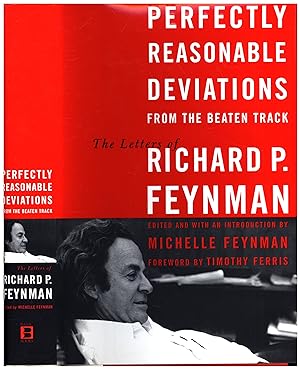






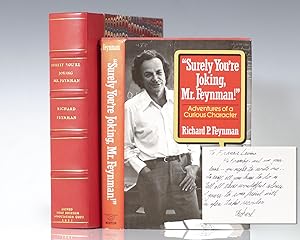
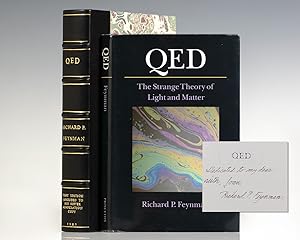

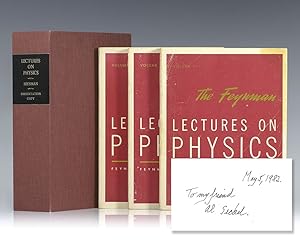
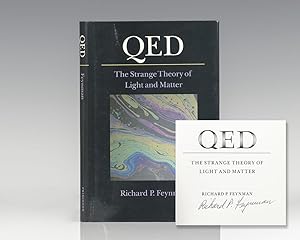
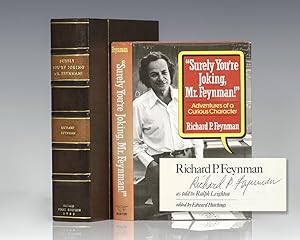

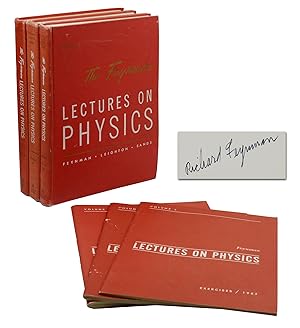
![Seller image for Typed Letter Signed [TLS] for sale by Manhattan Rare Book Company, ABAA, ILAB](https://pictures.abebooks.com/inventory/md/md31440727163.jpg)
![Seller image for Autograph Letter Signed [ALS] for sale by Manhattan Rare Book Company, ABAA, ILAB](https://pictures.abebooks.com/inventory/md/md30825621511.jpg)
